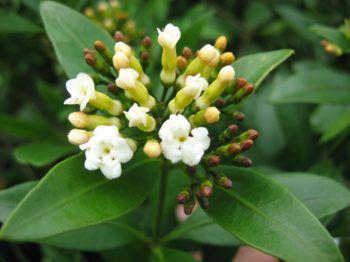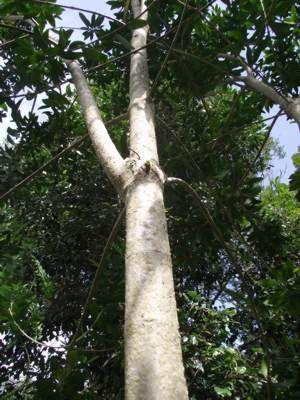Gonioma kamassi
Gonioma kamassi E.Mey.
Family: Apocynaceae
Common names: kamassi, Knysna boxwood (Eng.); kamassiehout (Afr.); igala-gala (isiXhosa)
Introduction
A small, unusual and rewarding, rounded, evergreen shrub with fragrant white or pale yellow flowers that are produced in small clusters at the ends of the branches. This is one the most common under-storey trees found in the Knysna forest.

Description
Description
An evergreen, large shrub or small tree that grows up to a height of 2 to 8 m. The stem is quite straight and slender. The bark is a pale grey-brown, very rough, fissured and corky especially on older stems, with a poisonous, watery or milky sap present. The leaves are opposite, leathery, shiny dark green above and paler beneath, with an entire margin, rolled under and tapering to a tip and are usually in whorls of 3 or 4.

The heavily scented yellowish white flowers are in compact, terminal clusters at the ends of the branches and appear throughout the year with a peak during spring (October). Fruit is paired, woody capsules that are held erect on the twigs, splitting open on the plant and releasing a number of papery-winged seeds in late summer (December-June). The wood is light yellow-brown, heavy and hard and is used for engraving and for fine inlay work.

Conservation Status
Status
This species is not threatened by any means in the wild and is assessed as Least Concern (LC) according to the Red List of South African Plants.
Distribution and habitat
Distribution description
This species occurs on sites with a temperate and fairly humid climate. It is found in evergreen forest and in scrub forest on cliff edges and is seldom far from the coast. It is endemic to Eastern Cape and Transkei with unusual records from northern KwaZulu-Natal and Mpumalanga, and is amongst the commonest understorey trees in the Knysna forest. Where one tree is found, others will certainly be nearby.

Derivation of name and historical aspects
History
Gonioma comes from the Greek word gonia, meaning ‘angle' because of the fruit that protrudes at right-angles to the stalk; kamassi is derived from the Khoisan name for this species. At one time this plant was an important export, although the pieces of its wood were never of any great size, it was used for carving and engraving. Bark and leaves produce a milky, poisonous sap.

Ecology
Ecology
Insects are attracted to the fragrance of this plant. The milky latex contained by the leaves fools an animal into quickly feeling full. If the grazer persists, the latex makes it feel sick and dizzy. The seed capsules split lengthways on ripening to release papery-winged seed, thus dispersing the seed.
Uses
Use
This is a lovely shade tree for small gardens. It is ideal for tall hedges. The hard timber from this tree has also been long used as a substitute for the European boxwood, Buxus sempervirens, family Buxaceae, in the manufacture of shuttles, tool handles, and similar objects in London.
Growing Gonioma kamassi
Grow
Gonioma kamassi is grown from seed. Seed is sown in a well-drained medium of fine sifted soil with river sand. Seed trays are placed in a warm position to optimize germination. Requires a sunny or semi shade, sheltered position and will perform well when mulched thickly with good compost, watered regularly and fed with a high nitrogen, organic or chemical fertilizer. This species does best when planted with other pioneer plants. It only really thrives in a warm, well-watered situation.
References
- Coates Palgrave, M.C. & Coates Palgrave, K.C. 2002. Trees of southern Africa. Struik, Cape Town.
- Johnson, D. & Johnson, S. 2002. Down to earth: gardening with indigenous trees. Struik, Cape Town.
- Pooley, E. 1993. The complete field guide to trees of Natal, Zululand and Transkei. Natal Flora Publication Trust, Durban.
- Witbos Indigenous Nursery: http://witbos.co.za/plant.aspx?plant=gonioma-kamassi&page=3 accessed October 2014
Credits
Sisanda Velembo
Kirstenbosch National Botanical Garden
October 2014
Plant Attributes:
Plant Type: Shrub, Tree
SA Distribution: Eastern Cape, KwaZulu-Natal, Mpumalanga, Western Cape
Soil type: Sandy, Loam
Flowering season: Early Summer, Late Summer
PH: Acid, Neutral
Flower colour: White, Cream
Aspect: Full Sun, Morning Sun (Semi Shade), Afternoon Sun (Semi Shade)
Gardening skill: Average
Special Features:
Horticultural zones









Rate this article
Article well written and informative
Rate this plant
Is this an interesting plant?
Login to add your Comment
Back to topNot registered yet? Click here to register.